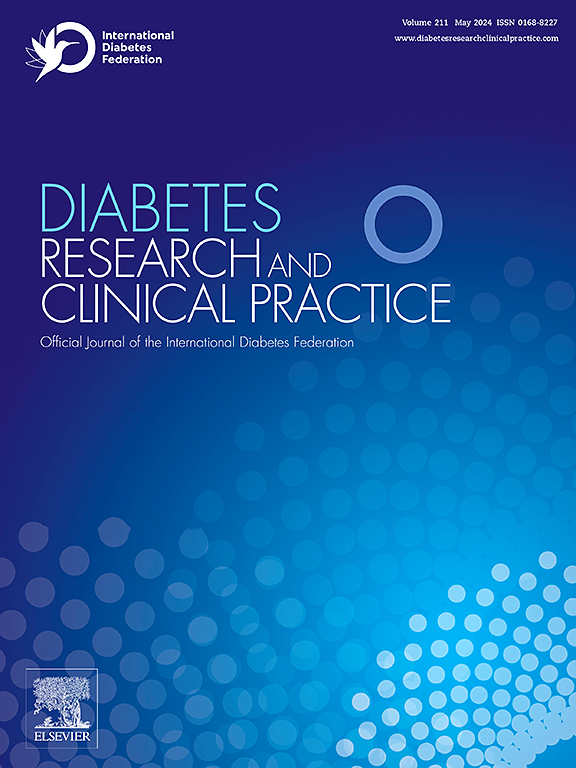SGLT2抑制剂、心血管预后和肾脏疾病的死亡率:系统回顾和荟萃分析。
IF 6.1
3区 医学
Q1 ENDOCRINOLOGY & METABOLISM
引用次数: 0
摘要
目的:评估SGLT2抑制剂对KDIGO和尿白蛋白与肌酐比值[UACR]组心血管预后和死亡率的影响:我们检索了截至 2023 年 8 月 8 日的 MEDLINE、EMBASE 和 CENTRAL。研究人员成对选择了SGLT2抑制剂的大型随机安慰剂对照试验,试验持续时间至少为一年。研究人员独立提取研究层面的数据,用 RoB 2.0 评估研究内部的偏倚风险,用 GRADE 评估证据的确定性。元分析采用随机效应模型:我们纳入了 14 项试验,涉及 97,412 名参与者,中位随访时间为 2.5 年。偏倚风险总体较低。总体而言,SGLT2抑制剂可减少主要不良心血管事件(MACE)(HR 0.89,95%-CI 0.85-0.93)、心血管死亡或心衰住院(HHF)(HR 0.78,95%-CI 0.75-0.82)、全因死亡(HR 0.89,95%-CI 0.83-0.94)和HHF(HR 0.71,95%-CI 0.67-0.75)。SGLT2抑制剂对MACE的影响在KDIGO组(Pinteraction = 0.038)和UACR组(Pinteraction = 0.008)有所不同,KDIGO极高组(HR 0.72,95 %-CI 0.61-0.86)和UACR > 300 mg/g组(HR 0.76,95 %-CI 0.68-0.86)获益更大:结论:SGLT2 抑制剂可降低心血管疾病的预后和死亡率。结论:SGLT2 抑制剂可降低心血管疾病的预后和死亡率,预计肾脏疾病高危人群的 MACE 降低幅度更大。本文章由计算机程序翻译,如有差异,请以英文原文为准。
SGLT2 inhibitors, cardiovascular outcomes, and mortality across the spectrum of kidney disease: A systematic review and meta-analysis
Aims
To evaluate the effects of SGLT2 inhibitors on cardiovascular outcomes and mortality across KDIGO and urinary albumin-to-creatinine ratio [UACR] groups.
Methods
We searched MEDLINE, EMBASE, and CENTRAL up to August 8th, 2023. In pairs, researchers selected large randomized placebo-controlled trials of SGLT2 inhibitors, with minimum duration of one year. Researchers independently extracted study-level data and assessed within-study risk of bias with RoB 2.0 and certainty of evidence with GRADE. Meta-analyses employed a random-effects model.
Results
We included 14 trials, encompassing 97,412 participants and a median follow-up of 2.5 years. Risk of bias was overall low. Overall, SGLT2 inhibitors reduced major adverse cardiovascular events (MACE) (HR 0.89, 95 %-CI 0.85–0.93), cardiovascular death or hospitalization for heart failure (HHF) (HR 0.78, 95 %-CI 0.75–0.82), all-cause death (HR 0.89, 95 %-CI 0.83–0.94), and HHF (HR 0.71, 95 %-CI 0.67–0.75). The effect of SGLT2 inhibitors on MACE was different across KDIGO (Pinteraction = 0.038) and UACR (Pinteraction = 0.008) groups, with greater benefits in KDIGO Very High (HR 0.72, 95 %-CI 0.61–0.86) and UACR > 300 mg/g (HR 0.76, 95 %-CI 0.68–0.86) groups.
Conclusions
SGLT2 inhibitors are associated with reductions in cardiovascular outcomes and mortality. Greater reductions in MACE are expected in subjects in high-risk groups for kidney disease.
求助全文
通过发布文献求助,成功后即可免费获取论文全文。
去求助
来源期刊

Diabetes research and clinical practice
医学-内分泌学与代谢
CiteScore
10.30
自引率
3.90%
发文量
862
审稿时长
32 days
期刊介绍:
Diabetes Research and Clinical Practice is an international journal for health-care providers and clinically oriented researchers that publishes high-quality original research articles and expert reviews in diabetes and related areas. The role of the journal is to provide a venue for dissemination of knowledge and discussion of topics related to diabetes clinical research and patient care. Topics of focus include translational science, genetics, immunology, nutrition, psychosocial research, epidemiology, prevention, socio-economic research, complications, new treatments, technologies and therapy.
 求助内容:
求助内容: 应助结果提醒方式:
应助结果提醒方式:


